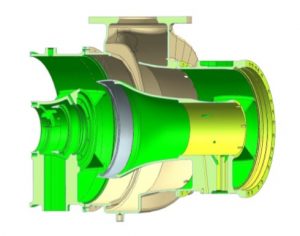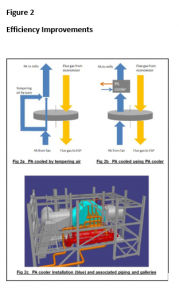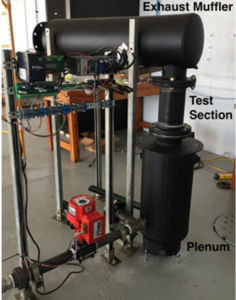3D Printing Improves Testing for Gas Turbine Components
 Gas turbines are complex components to manufacture, but additive manufacturing has been successfully utilized to accelerate design cycle times, reduce development test times, provide better test data and reduce the overall time to the release of the final component. It also allows for testing to be performed earlier, as early as the concept or preliminary design phases. This means that there is less likelihood that the entire component will have to be redesigned, as problem areas can be detected and eliminated early.
Gas turbines are complex components to manufacture, but additive manufacturing has been successfully utilized to accelerate design cycle times, reduce development test times, provide better test data and reduce the overall time to the release of the final component. It also allows for testing to be performed earlier, as early as the concept or preliminary design phases. This means that there is less likelihood that the entire component will have to be redesigned, as problem areas can be detected and eliminated early.
In a recent case study, a Siemens Energy SGT-A05 industrial gas turbine engine line was manufactured, and additive manufacturing was used for aerodynamic development testing within the preliminary design phase for boundary condition definition of new compressor static flow path components.
“The model test section for this work was designed to characterize the influence of the internal flow passage and the exit plane flow coming from the zero-stage compressor both with and without handling bleeds active,” the manufacturing team explains. “The flow passage is defined with a symmetric center-body, which represents a combination of rotor components and static end walls, and an asymmetric outer-body for bleed. All structural static internal components, e.g. struts used for sump services and bearing support, were included in the model. The test model was a geometrically similar 1/5th scale model of the stage 0 module of the engine. Focus for the test models was on the internal static flow path features only and, where possible, split line effects associated with the actual engine assembly were replicated.”
T he parts were 3D printed using a Formlabs Form 2 3D printer, and once they were cured, they were fastened together using epoxy to create an airtight and spatially correct flow path. To improve the overall strength, the assembly was then epoxied into an 8-inch diameter, standard-wall, black-iron pipe section and back-filled with a polyester resin. The whole process, from CAD drawings to creating the assembly, took about two weeks and 30 man hours of work.
he parts were 3D printed using a Formlabs Form 2 3D printer, and once they were cured, they were fastened together using epoxy to create an airtight and spatially correct flow path. To improve the overall strength, the assembly was then epoxied into an 8-inch diameter, standard-wall, black-iron pipe section and back-filled with a polyester resin. The whole process, from CAD drawings to creating the assembly, took about two weeks and 30 man hours of work.
Two different model standards were tested over 20 different inlet conditions, completed in less than five months. Several repeated tests were conducted to assess data quality, reproducibility, and the consistency of transient effects. All of the testing indicated high accuracy and low variability.
“Results from testing have demonstrated high value to the current re-design program,” the team states. “Not only was the data made available during the entire preliminary design phase, working between test and engineering allowed easy utilization of the data being generated. In general, this new boundary condition data has demonstrated direct benefits to the current design, which incorporates a non-axis symmetric inlet profile feeding the high pressure compressor and also has incorporated factors which mimic the noted dynamic pressure effects associated with bleed into the design.”
 Overall, it was determined that using additive manufacturing greatly improved the testing process, with the following aspects noted:
Overall, it was determined that using additive manufacturing greatly improved the testing process, with the following aspects noted:
- Rig development time was improved by roughly an order of magnitude
- Rig and test component prototype costs were reduced by three times
- The technical validity of the results was only slightly lower than fully instrumented engine test results but improved relative to typical component testing
- The test results showed exceptional agreement to full scale 3D CFD results driven by rig test defined boundary conditions
- The total cost comparison of current vs. conventional testing was four to 10 times lower and resulted in more than an order of magnitude more data
You can read the full study here.
Discuss this and other 3D printing topics at 3DPrintBoard.com or share your thoughts below.
Subscribe to Our Email Newsletter
Stay up-to-date on all the latest news from the 3D printing industry and receive information and offers from third party vendors.
Print Services
Upload your 3D Models and get them printed quickly and efficiently.
You May Also Like
3D Printing Financials: 2024 Results In, Nano Dimension Gears Up with Markforged and Desktop Metal
Nano Dimension (Nasdaq: NNDM) is going through a major transformation. In just a few weeks, the company has finalized not one, but two major acquisitions: Desktop Metal and Markforged. On...
Velo3D Secures $22M Metal 3D Printing Powder Supply Deal with Amaero
Velo3D (OTCMKTS: VLDX) has signed a major new agreement with metal 3D printing powder manufacturer Amaero (ASX: 3DA). The five-year deal is valued at USD $22 million and centers around...
3D Printed Heat Exchanger Specialist Conflux Technology Expands into the UK
Melbourne’s Conflux Technology, a specialist in using additive manufacturing (AM) to produce heat exchangers, is opening a business hub in the UK. The new site, which will open sometime in...
Rob Higby: How Continuum’s Scrap-to-Powder Model Caught Siemens’ Attention
Continuum Powders has spent over a decade working on a bold idea: why mine new metal when high-quality material is already flowing through today’s factories as scrap? Now, thanks to...





























